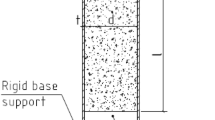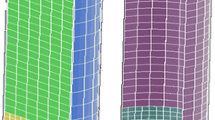Abstract
The flexural behavior of circular concrete-filled steel tubes (CFST) is addressed in the present paper, with the aim of understanding the contribution of the concrete infill and the steel tube to the flexural stiffness under in-service loads. The provisions given by current codes of practice are oversimplified and they result in a very different contribution of the concrete infill from one code to another. In the present paper, a mechanical approach is proposed by taking into account the stress transfer mechanism from the steel to the concrete through bond stresses. The paper firstly addresses the response of the cracked section in pure bending. Secondly, a tension chord model for CFST is proposed, so that the contribution of concrete in tension between cracks (tension stiffening) can be evaluated. The model capabilities are compared with experimental results from the scientific literature and with own experimental results of the author, showing that the proposed approach can predict the flexural stiffness of CFST very satisfactorily. For the first time, a model with sound mechanical background is introduced to calculate the bending stiffness of CFST.








Similar content being viewed by others
Abbreviations
- A c :
-
Concrete area
- A ct,eff :
-
Effective concrete area in tension
- A s :
-
Steel area
- D :
-
Diameter
- E c :
-
Concrete modulus of deformation
- E s :
-
Steel modulus of elasticity
- EI :
-
Flexural stiffness
- EI cr :
-
Cracked stiffness
- E c I c :
-
Flexural stiffness of the uncracked concrete infill
- E s I s :
-
Flexural stiffness of the hollow steel tube
- M :
-
Bending moment
- T :
-
Tensile force
- T s , T c :
-
Tensile force carried by steel and concrete, respectively
- U s :
-
Perimeter of the steel–concrete contact
- f c :
-
Concrete compressive strength
- f ct :
-
Concrete tensile strength
- f y :
-
Steel yielding strength
- s r :
-
Crack spacing
- s rm :
-
Average crack spacing
- t :
-
Thickness
- x :
-
Abscissa
- x cr :
-
Neutral axis depth
- y :
-
Vertical coordinate, from the center of the tube
- z :
-
Distance of a fiber of the cross-section from the neutral axis
- αx :
-
Semi-angle to define the effective concrete area in tension
- εs, εc :
-
Steel and concrete strain, respectively
- εsm :
-
Average strain at the centroid of the tension chord
- κ:
-
Curvature
- κcr :
-
Curvature of the cracked section
- κm :
-
Average curvature
- θ:
-
Angular coordinate
- θcr :
-
Angular coordinate of the neutral axis
- σs, σc :
-
Steel and concrete stress, respectively
- τ:
-
Bond stress
References
AIJ. (2008). Recommendations for design and construction of concrete filled steel tubular structures. Tokyo: Architectural Institute of Japan.
AISC. (2016). AISC 360-16. Specification for structural steel buildings. Chicago, IL: American Institute of Steel Construction.
Balazs, G. L. (1993). Cracking analysis based on slip and bond stresses. ACI Materials Journal, 90(4), 340–348.
CEN. (2004). Eurocode 4 EN 1994-1-1:2004. Design of composite steel and concrete structures. Part 1-1: General rules and rules for buildings. Brussels: European Committee for Normalization.
CEN. (2008). Eurocode 3 EN 1993-1-1:2008. Design of steel structures. Part 1: general rules and rules for buildings. Brussels: CEN.
Chitawadagi, M. V., & Narasimhan, M. C. (2009). Strength deformation behaviour of circular concrete filled steel tubes subjected to pure bending. Journal of Constructional Steel Research, 65, 1836–1845.
Cosenza, E., & Pecce, M. (2001). Shear and normal stresses interaction in coupled structural systems. Journal of Structural Engineering, 127(1), 84–88.
Elchalakani, M., Zhao, X. L., & Grzebieta, R. H. (2001). Concrete-filled circular steel tubes subjected to pure bending. Journal of Constructional Steel Research, 57, 1141–1168.
FIB. (2013). Model code for concrete structures 2010. Lausanne: FIB.
Gilbert, R. I. (2007). Tension stiffening in lightly reinforced concrete slabs. Journal of Structural Engineering, 133(6), 899–903.
Han, L. H. (2004). Flexural behaviour of concrete-filled steel tubes. Journal of Constructional Steel Research, 60, 313–337.
Han, L. H., He, S. H., & Liao, F. Y. (2011). Performance and calculations of concrete filled steel tubes (CFST) under axial tension. Journal of Constructional Steel Research, 67, 1699–1709.
Han, L. H., Lu, H., Yao, G. H., & Liao, F. Y. (2006). Further study on the flexural behaviour of concrete-filled steel tubes. Journal of Constructional Steel Research, 62, 554–565.
Lu, Y. Q., & Kennedy, D. J. L. (1994). The flexural behaviour of concrete-filled hollow structural sections. Canadian Journal of Civil Engineering, 21, 111–130.
Marti, P., Álvarez, M., Kaufmann, W., & Sigrist, V. (1998). Tension chord model for structural concrete. Structural Engineering International, 98(4), 287–298.
Nardin, S. D., & El Debs, A. L. (2007). Shear transfer mechanisms in composite columns: An experimental study. Steel and Concrete Structures, 7(5), 377–390.
Newmark, N. M., Siess, C. P., & Viest, I. M. (1951). Tests and analysis of composite beams with incomplete interaction. Proceedings of the Experimental Stress Analysis, 9(1), 75–92.
Ranzi, G., Gara, F., & Ansourian, P. (2006). General method of analysis for composite beams with longitudinal and transverse partial interaction. Computers & Structures, 84, 2373–2384.
Zanuy, C. (2015). Analytical equations for interfacial stresses of composite beams due to shrinkage. International Journal of Steel Structures, 15(4), 999–1010.
Zanuy, C., De la Fuente, P., & Albajar, L. (2010). Estimation of parameters defining negative tension stiffening. Engineering Structures, 32(10), 2908–2920.
Zanuy, C., De la Fuente, P., & Pinilla, M. (2012). Bending strength of threaded connections for micropiles. Journal of Constructional Steel Research, 78, 68–78.
Author information
Authors and Affiliations
Corresponding author
Rights and permissions
About this article
Cite this article
Zanuy, C. Tension Chord Model and Flexural Stiffness for Circular CFST in Bending. Int J Steel Struct 19, 147–156 (2019). https://doi.org/10.1007/s13296-018-0096-9
Received:
Accepted:
Published:
Issue Date:
DOI: https://doi.org/10.1007/s13296-018-0096-9




